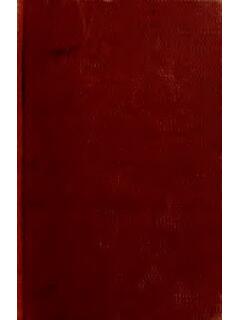Transcription of Learning To Play The Guitar – An Absolute …
1 Learning To play The Guitar An Absolute beginner s Guide By anthony Pell All Rights Reserved. No part of this publication may be reproduced in any form or by any means, including scanning, photocopying or otherwise without prior permission of the copyright holder. Copyright anthony Pell 2013 Acknowledgements Thanks to Elliott, John, Justin, Paul and most of all Rachael. IntroductionLesson 1 The GuitarParts of the Guitar - Main Types of Guitar - Guitar Accessories & Practice Tools - Holding the Guitar The Notes of Music - Tuning - Finger Numbers - Holding the Pick Lesson 2 Practicing Daily Practice - Practice Log Lesson 3 Picking Using the Guitar Pick - The 5 Picking Exercises - Using a Metronome Lesson 4 Chords & Strumming A D & E Major Chords - "Wild Tune" - Changing Between A D & E Major Lesson 5 Chords & Strumming Major & Minor Chords - G Major & E Minor Chords - Strumming Patterns & Rhythms - Strumming with a Metronome - "Sit With Me" - C Major Chord - 5 String Strumming Lesson 6 Chords & Strumming Sugar House Alhambra - Faster Chord Changes - Changing Between D & C, C & G.
2 G & D Major Chords Lesson 7 Chords & Strumming A Minor Chord Tapping on Gods Gate - E7 Chord Yo Jim Lesson 8 Chords & Strumming D Minor Chord DDU-UDU Strumming Pattern White Witch Lady - F Major Chord The 4 Chord Song - G7 Chord Lesson 9 Chords & Strumming Using a Capo Lesson 10 Chords & Strumming Power Chords - A D & E Power Chords Wild Tune Open E A & B Power Chords Real Crazy Kid Lesson 11 Arpeggios 6/8 time signature Everyone Feels Everything Else Does Lesson 12 Arpeggios Sugar House Alhambra House of the Rising Sun Lesson 13 - Scales Major Scales - C Major Scale - Octave - G Major Scale F Major Scale Lesson 14 Scales Steps of a Major Scale - Key Signatures - D Major Scale Lesson 15 - Scales Using The Major Scales - C Major Scale for The 4 Chord Song - G Major Scale for Sit With Me - D Major Scale for Everyone Feels Lesson 16 - Scales Pentatonic Scales E Minor Pentatonic Scale Everything Else Does - A Minor Pentatonic Scale Wild Tune Lesson 17 - Scales Blues Scales - E Blues Scale A Blues Scale - Examples of Scales in Songs Lesson 18 Blues & Rock n Roll 12 Bar Blues - A7 D7 E7 Chords - Swing Rhythm - 12 Bar Blues in A - Spread Rhythm Lesson 19 Blues & Rock n Roll Lead Guitar Techniques - String Bending - Hammer On - Blues in A Solo Lesson 20 Blues & Rock n Roll Blues in E - B7 Chord - B Spread Rhythm - 12 Bar Blues in E - Slides- Blues in E Solo Lesson 21 ImprovisingHow to Improvise Wild Tune Sit With Me Tapping on Gods Gate Sugar House Alhambra Yo Jim White Witch Lady The 4 Chord Song Completely Crazy Kid Everyone Feels Everything Else Does House of the Rising Sun Blues in A Blues in E Conclusion This book is written for Absolute beginners wanting to learn the basics of playing the
3 Guitar . By the end of the book you should be able to play many songs using a range of skills required to play the Guitar . If you ve always wanted to learn to play the Guitar but didn t know where to start this is the book for you. The book is divided into 21 lessons covering a range of Guitar techniques to get you playing. The best way to use this book is to work on one lesson a week or until you have mastered the lesson s exercises and songs before moving onto the next lesson. You may find that that some lessons require more time or you may move faster through some lessons than others. This all depends on how much you practice. Here is an overview of what the lessons in the book cover. The Guitar , Practicing & Picking Lessons 1- 3 This is all about Learning the parts of the Guitar , essential accessories and practice tools. You will also learn how to hold the Guitar , finger numbers, how to hold a Guitar pick and practice with picking exercises.
4 To improve and maintain your Guitar skills regular practice is essential so practice tips are included here. Chords & Strumming Lessons 4-10 You will learn the main chords used in thousands of songs, how to change between them and strumming patterns to suit a range of music styles including rock, pop, folk, blues and country. Arpeggios Lessons 11-12 Arpeggios are simply chords played one note at a time. A famous example of this technique on Guitar is the start to Led Zeppelins "Stairway to Heaven". Arpeggios can make simple chords sound more interesting and they sound great in slow songs and ballads. Scales Lessons 13-17 Single note / lead Guitar playing will also be looked at with an introduction to scales and how they're used to play melodies and Guitar solos. Blues & Rock n Roll Lessons 18-20 All the previously covered skills will come together as you are introduced to the blues which is the foundation for rock n roll, jazz, soul and rhythm and blues music.
5 The blues is also great fun for jamming with other guitarists and musicians and is an essential style to learn for any aspiring guitarist. Improvising Lesson 21 Tips to improvise are given here with all the songs used in the book listed with their matching scales and links to their backing tracks to practice with. Mp3 Audio Samples & Video Lessons To help you learn to play the Guitar the book features many photos, diagrams, exercises and songs. The exercises and songs also include links to mp3 audio samples so you can hear what they sound like as you progress through the book. There are also numerous video lessons that compliment the lessons in the book. Look out for the Mp3 Track and Video icons and links to these audio and video files. For those of you reading this on an eReader such as a Kindle you may have to use a PC or Mac to download the audio files and view the video lessons. These can be all found here Thank you for downloading this book.
6 I hope that you find this book to be helpful in Learning how to play the Guitar . Please rate and review this book on Amazon. So let s start Learning to play the Guitar ! Back to Table of Contents Parts of the Guitar - Main Types Of Guitar - Guitar Accessories & Practice Tools - Holding The Guitar The Notes Of Music - Tuning - Finger Numbers - Holding The Pick Parts Of The Guitar Before we start playing it s a good to get familiar with the parts of the Guitar . While there are differences between various types of guitars all have the same main parts. The picture below is of a steel string acoustic Guitar . Main Types of Guitar There are 3 main types of Guitar , nylon string acoustic (classical), steel string acoustic and the electric Guitar . Each has their own pros and cons and differences in tone that makes them suit different styles of music. Nylon String Acoustic Guitars The nylon string or classical Guitar is traditionally used in classical, flamenco and folk music.
7 The sound of this Guitar is much more mellow and rounded than a steel string acoustic and tends to sound better played with the finger tips verses being played with a pick. The advantage for beginners is that the nylon string Guitar is much easier on the fingertips than steel strings because nylon is a much softer material than steel. Also the cost of a reasonable quality nylon string acoustic Guitar is fairly cheap and is often less than an equivalent quality steel string Guitar . Steel String Acoustic Guitars Steel string acoustic guitars are more often used in rock, country, blues and also in folk music. The sound of this Guitar is much brighter and louder than a nylon string acoustic and generally is more suited to strumming chords or playing with a Guitar pick than the nylon string Guitar . One disadvantage for beginners with the steel string Guitar is that it s tougher on the fingers with the steel strings being much less forgiving on beginner s fingertips than nylon strings.
8 It can take a few weeks of daily practice to develop calluses on your finger tips to help reduce the initial pain of playing a steel string acoustic. Also, the cost of a reasonable quality steel string acoustic Guitar is usually more than an equivalent quality nylon string Guitar . Electric Guitars Electric guitars work through the vibrations of the steel strings being transmitted to the pickups on the instrument then onto a Guitar amplifier creating the sound. This allows for electric guitars to be very loud with their volume only being limited by the power or size of the amp. Electric guitars and amps often use effects like distortion for longer sustain (longer sounding notes). Guitarists like Jimi Hendrix revolutionised the sound of the electric Guitar by using distortion at high volumes to create sustain that allowed him to play long notes that simply cannot be played on an acoustic Guitar . Electric guitars are easier to play than steel string acoustics as the string gauge (thickness) is smaller.
9 It allows guitarists in Guitar solos to bend the strings easier which is essential for playing blues and most modern rock Guitar . Guitar ACCESSORIES AND PRACTICE TOOLS Guitar Pick The Guitar pick is also called a plectrum. These help you to strum chords and play individual notes louder and faster than with just using your fingers. It's best to use a hard pick around 1mm thick. Paper thin picks are OK for lightly strumming chords but are too floppy for playing individual strings accurately when playing melodies and arpeggios. Electronic Tuner An electronic Guitar tuner will help you to easily tune the strings of the Guitar to the correct notes. The tuner will show a needle that will be placed in the middle when the string is in tune. Some tuners have a microphone to pick up the sound of the note while other clip-on Guitar tuners attach to the Guitar headstock and pick up the vibration of the string when it's plucked. Guitar Strap A strap enables you to play the Guitar standing up by connecting to strap pins or buttons on the Guitar body.
10 Foot Stool This is used when sitting to raise the leg holding the Guitar body when playing in a sitting position. Capo A capo enables you to play in different keys (See Lesson 14 Scales Key Signatures) using easier open string chords and avoiding the more difficult bar chords. They work by being clamped on the fret board to create a temporary nut changing the tuning of the Guitar . (See Lesson 9 Chords & Strumming Using a Capo) Metronome This practice tool creates a steady beat or click to play with. There are many types from the old pendulum ones to electronic and software versions. Software metronomes are quite popular as they're often free and can be downloaded from the Internet onto your PC. They are also many free metronome apps for smartphones and tablets too. Further details on how to use a metronome will be explained in the (See Lesson 3 - Picking Using A Metronome) This tuner includes a metronome function which is highlighted in the red squares showing that this metronome is set to play at 120 beats per minute (BPM).




